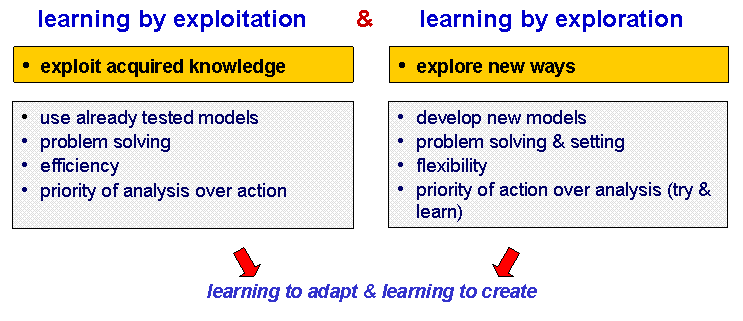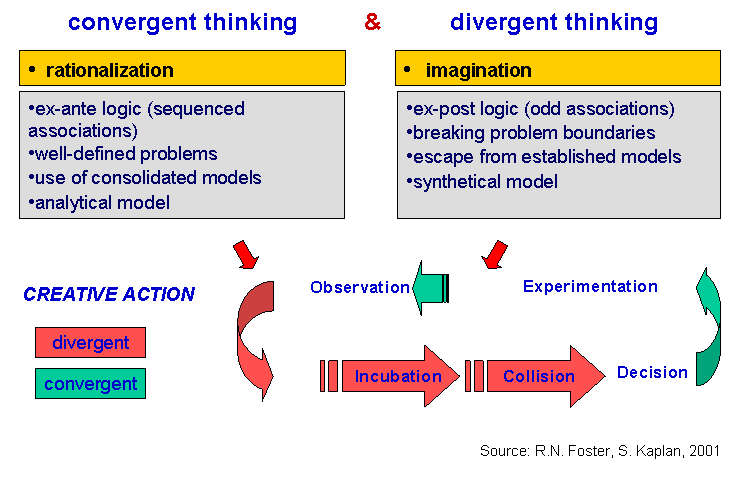We said that creativity is an evolutive process which is characterized by a fundamental aptitude, which is the capability of changing in a not already determined way. The concept of evolution is considered also by R.N. Foster and S. Kaplan, two McKinsey’ s consultants, who say that
| “Enterprises need to be re-imagined in order to strengthen their capability to evolve, instead of their capability to perform” |
The authors think that this is possible just overcoming some dichotomies such as the emphasis on discontinuity on one hand and on continuity on the other one, the contrast between creating and operating, but also between divergence and convergence, and finally between control on one hand and freedom of action and risk on the other one.
Fig 1 – Organizational creativity

As to the first dichotomy, i.e. continuity vs. discontinuity. we can say that generally enterprises are planned and built on the principle of continuity. It means that organizations are not able to innovate with the same rhythm of the market as they are focused on their operative processes. The problem is that they cannot create an organizational environment enhancing the development of new ideas and the rapid elimination of the old ones. This is due to the fact that enterprises are subjected to cultural blocks, which lead to make strategic planning mistakes and which induce defensive routines determining a low capability to innovate. But the reality of the market is quite different. Markets work on the assumption of discontinuity and this means that they can create more surprise and innovation than enterprises. This is due to the fact that they have no control systems, no culture, no mind models which can induce some defensive routines. They have no regrets; they eliminate the weakest operators and by making this they increase global returns.
Fig 2 – Continuity vs discontinuity

In order to accept the principle of discontinuity organizations have to change their focus from operational excellence to creating and innovating. In fact operational excellence is any more sufficient to evolve with the same rhythm and intensity of the market. And then it is necessary to adopt an other approach. Traditional management focuses on analysis and control, on a high level of productive efficiency, logistical and commercial competences, on a good executive capability.
Fig 3 – Operating vs creating

Enterprises who want to use this kind of approach have to enhance the variety of their mind models because markets are not characterized by a great uniformity of thinking. In particular this fact requires being able to use both divergent and convergent thinking.
The aim of the divergent thinking is modifying the definition of a problem or the context where it should be solved. It means having a variety of perspectives, making unusual associations,realizing what Koestler[1] defined as a “cross fertilization” which means connecting people with different experiences and cultures for example.
Moreover divergent thinking is made up of three phases which are: the research of a problem (because the creative process start with the perception of a problem or a task to realize); incubation during which people have to suspend their judgment to increase the possibility of reaching an original vision of the problem; then we can say that incubation is just the opposite of usual business processes which take place in an operational organization. Finally we have the collision which means creating a new idea by connecting different information and perspectives.
These three phases define the process of divergent thinking which is the source of creative process, but the problem is that these competences are never developed by organizations, which are generally focused on convergent thinking.
We can say that convergent thinking is the second part of the creative process. This kind of thought is fundamental for the analytical activity and it is measured by intelligent quotient testing. It is concerned with well-defined and rational problems which have just one right answer. This is an analytical thinking which focuses on essential details, selections ideas according to their relevance and simplifies problems considering only the most significant details. Organizations usually apply convergent thinking to operational problems, but the act of creation is quite different from those kinds of problems. Creative processes require on one hand some divergent activities such as research (that is observation),incubation (reflection) and collision (which may start from a conversation). On the other hand we have convergent activities such as taking decisions and experimenting (testing) them.
Fig. 4 – Convergernce vs divergence

The problem is that controlling creativity requires changing people and contexts, that is to say putting into balance discontinuity and continuity, divergence and convergence and finally control and freedom of action. In fact what makes the creative process something very difficult for enterprises is giving employees the possibility of developing their ideas and of making some mistakes too. Then on one hand we have traditional management which uses control in order to eliminate surprise, create a stable environment, avoid to take excessive risks. While on the other hand there’s the necessity of enhancing a spirit of entrepreneurship which requires a certain freedom of action, that is to say the possibility of translating one’s own ideas into something practical and of making mistakes too.
Fig. 5– Control vs freedom of action

| <--PREVIOUS | BACK TO TOP | INDEX | NEXT--> |